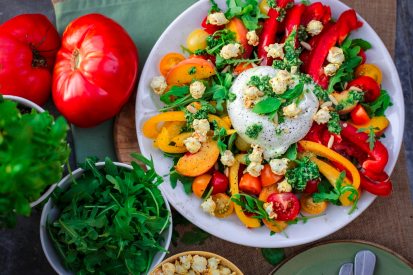Here are some of the most popular Fat-Loss Cookbook Editions:
- Keto Resources
- The Fat Burning Kitchen
- Paleo Diet
- Metabolic Cooking – Fat Loss Cookbook
- Anabolic Cooking – Muscle Building Cookbook
1. Keto Resources (click to buy)
28-Day Meal Plan and 10 expert guides to educate and inspire you
1 Keto Diet Basics
To get started, you’ll learn the basics of the keto diet, how it was developed, how it works, 13 tips for success, foods to enjoy, and more.
2 Eating Well On Keto
In this guide, you’ll get 10 breakfast recipes, 14 lunch recipes, and 14 dinner recipes, plus a companion 28-Day Meal Plan calendar.
3 Staying In Ketosis
You’ll learn how to get into ketosis in as little as 3 days, how to know if you’re in ketosis, and much more.
4 Mastering Macros
Learn how to calculate your macronutrients and maintain the proper ratios to stay in ketosis!
5 Beating Keto Flu
What the “Keto flu” is and how to make it go away quickly if you experience any symptoms.
6 Intermittent Fasting
Learn about 5 different styles of Intermittent Fasting to kickstart ketosis and accelerate fat loss.
7 Social Situations
Discover healthy ways of dealing with social pressures. Includes tips for eating out and guidelines for drinking alcohol. This is what makes weight loss sustainable!
8 Guilt-Free Desserts
This cookbook contains 36 mouth-watering “fat bomb” recipes that will satisfy your sweet tooth while keeping you in ketosis.
9 Yummy Avocado Recipes
Discover 5 unique keto-friendly ways to prepare avocados. Yum!
10 Keto Supplements Guide
Learn about 12 of the best Keto supplements that will help you transition to ketosis and make the Ketogenic diet more effective.
Amaze Yourself… In Just 28 Days
- Be lighter and thinner… it’s not uncommon to lose 20+ pounds!
- Have more energy than you’ve felt in years
- Sleep better and wake up more rested
- Notice your skin and hair improve
- Feel a sense of accomplishment
- Best of all… you’ll GAIN MOMENTUM with your new Keto lifestyle.
02. The Fat Burning Kitchen (click to buy)
Your 24-Hour Diet Transformation to Make Your Body a Fat-Burning Machine
Inside this brand new manual, you’ll discover:
- The true secret to making calorie-counting obsolete … this is the same principle that will automatically eliminate your cravings and control your appetite permanently (it’s the same reason that I personally haven’t had a real “craving” in at least 7 years)
- The truth about polyunsaturated fats (omega-6’s and omega-3’s) that most food companies don’t want you to know
- Which protein bars or energy bars are actually candy bars in disguise and which bars are actually good for you
- The real deal on saturated fat and cholesterol, and why they are essential in your diet (Without enough saturated fats and cholesterol in your diet, you can actually HARM your hormone balance)
- The “whole grain” deception and why whole grain crackers, breads, and cereals are packing more bodyfat on you
- Why that skim milk may not be so good for you after all, and the dirty truth about homogenized milk too
- The one time when tilapia and salmon are NOT health foods (plus the best alternatives)
- A healthy fat-burning burger option? Yes
- Why soymilk, tofu, and veggie burgers could be increasing your belly fat
- Are sports drinks stifling your fat-burning and making you AGE faster?
- The ONLY truly healthy options for sweeteners … even non-caloric sweeteners
- A surprisingly healthy fat in some animal products that actually helps you burn fat & build muscle (it even helps to fight cancer)
- Why egg whites are actually WORSE for you than whole eggs
- Do diet sodas and other diet drinks hurt your fat loss efforts?
- Is whole milk actually better for you than skim milk? There’s more to the story
- A type of saturated fat that actually helps to stimulate your metabolism
- The one time when delicious creamy chocolate can even help to prevent your sweet tooth cravings (It even helps improve your blood pressure too!)
- Does green tea or oolong tea really increase your metabolism and help fat loss? The truth
- Which fruits & veggies are okay to choose non-organic
- …and TONS more secrets to help you permanently transform your diet to force your body to burn fat more effectively, while also preventing diabetes.
03. Paleo Diet (click to buy)
Paleohacks Cookbooks
01. The PaleoHacks Cookbook
Over 125 Mouth-Watering Recipes
- Simple, Easy, Amazingly-Yummy Paleo Recipes
With a wide variety of easy-to-make Paleo-friendly meals that will get rave reviews from friends and family every time!
- Clear Directions Anyone Can Follow
There’s no guesswork, we walk you through each recipe with 100% crystal-clear detail, making SURE you’re able to prepare the dish
- Absolutely Everything You Need
..to follow the healthiest diet in the world and to start achieving the health, energy, vitality and weight loss results you want!
02. The PaleoHacks 30-Day Jumpstart
To help you get going immediately!
- Don’t want to wait? Want to get started getting the health results you want immediately? Then this Jump Start guide is for you.
- This jump start guide will get you started on your Paleo Diet journey, and make sure that you are able to actually make a permanent, positive change in your health.
- With this guide, the struggle to reach your health goals will end. When you pick the right foods and approach your health properly, your quality of life – from your energy levels, happiness, sex drive, and more, will improve.
- So if you want to dive right in and get going as fast as possible, make sure to read this bonus.
03. The Eating Paleo at Restaurants Guide
So you can still eat out and have fun!
- As you go through your Paleo journey, inevitably you’re going to go out to eat. Instead of struggling to pick the best paleo meals on the menu, we’ve created this guide to show you how to eat at restaurants without any issues.
- This guide will show you:
How to eat at restaurants and stay Paleo
- Sample meals you can order at restaurants
- (delicious AND available almost anywhere)
- How to avoid foods that secretly have gluten or dairy in them
- (And how to ask your waiter to make sure they don’t mess up!)
04. The Paleo Foods and Fails Guide
All the healthiest Paleo foods + shopping lists!
- One of the biggest complaints people have about the Paleo Diet is that there is a lack of food choices. Well let me tell you – with this program you will NEVER have a lack of choices. Just from expanding vegetables alone, you add hundreds of delicious meal combination opportunities.
- With this food guide, you’ll have a complete list of foods to choose from, and open up new delicious meals for you to eat!
- This guide will give you:
The complete list of healthy, delicious paleo foods
- A list of foods and their seasonality (so you know which foods are fresh any time of the year)
- Your Paleo Shopping List – so you know exactly what to get at the store
05. The Paleo 4X Cookbook
How the “pros” often eat each day!
- If you hate spending time in the kitchen, and just want to get in and out with a delicious, paleo friendly meal, this cookbook is filled with recipes that use JUST 4 INGREDIENTS. These recipes include some from the most experienced eaters in our Paleohacks community.
This book will give you:
- 65 easy, quick paleo recipes that you can cook anytime
- Your freedom back – you’ll save hours and hours in the kitchen.
- The end to struggling for ideas to create quick healthy meals – you’ll never be at a loss for what to make in the kitchen.
06. The One-Month Paleo Meal Plan
So you always know what to eat!
- In this final free guide, we’ll give you our entire meal plan with 125 delicious recipes from the Paleohacks Cookbook. Whether you’re just getting started or a seasoned veteran, this guide will show you exactly what to eat and how much to eat. You just choose when you want to eat it!
- With this guide – you won’t have to think at all when it comes to the Paleo Diet – everything will be laid out in front of you in easy, simple to follow steps.
04. Metabolic Cooking – Fat Loss Cookbook (click to buy)
The Complete Metabolic Cooking Package
- We Have Developed The Simplest And Fastest Way To Preparing And Eating Delicious Fat Burning Meals Every Day For The Rest Of Your Life
- The 9 part cookbook that will teach you how to make your own tasty fat torching meals that will once and for all give you the opportunity to get the results and the body you deserve!
You will find 250 quick and easy “Metabolicious” recipes to prepare:
- Breakfast
- Snacks
- Sides
- Smoothies
- Red Meat
- Pork
- Chicken & Poultry
- Fish & Seafood
- Vegetarian
Metabolic Cooking makes fat loss taste a lot better and will make you a lot simpler! This is a must-have in your kitchen.
Free Bonus #1: The Fat Loss Optimizer Guide
- Our Complete Fat Loss Optimizer Guide is loaded with all the information that you must know in order to burn fat faster and master the art of fat loss cooking and nutrition. It will teach you:
- What top fat burning foods you must eat to burn fat faster.
- Our 10 Rules of Metabolic Cooking for guaranteed success.
- How to use the Metabolic Nutri-Profile, time your meals, and how much food you need to eat.
- How to create your own individualized meal plan in minutes.
- Money saving and grocery shopping tips.
- And much, much more.
- Everything you need to know to optimize your fat loss results is covered in this guide!
Free Bonus #2: The Metabolic Salad Builder and Metabolicious Dressings
- In our Metabolic Salad Builder, we’ll show you how to create the ultimate fat burning salads that will stimulate your metabolism so that you burn more body fat than ever!
- With this Metabolic Salad Builder, you will also find our Metabolicious Dressings guide to enhance the taste and metabolic powers our salads. Our famous calorie-free Metabolicious Salad Dressings will enhance your metabolism, someting that the chemical and sugar filled so-called “healthy dressings” are not going to do!
Free Bonus #3: The Thermo-Charged Seasoning Guide
- There are always going to be those days when you’re simply in a huge rush and don’t have time to cook. No problem! That’s where our Thermo-Charged Seasonings come into play.
- What we’ve done here is created some Sodium Free Thermo-Charged Seasonings that will spice up any bland pre-cooked chicken breast (or whatever protein source you’re using) into a taste sensation. Not only will this quick meal on the go taste good, but it’ll still have similar metabolic enhancing powers as all of the other recipes in our cookbooks. The addition of these seasonings will literally take you all of 20 seconds, but the difference on your rate of fat loss compared to if you had not done this will be profound. Fat loss really does not get much easier than this!
Free Bonus #4: Metabolic Cooking Quick Sheets
- Last but not least, we have created the Metabolic Cooking Quick Sheets to make your life even more simple! It includes:
- A quick recipe finder list.
- An easy conversion chart (for our overseas friends).
- Our grocery shopping masterlist.
- A printable daily food log.
- Our personal online shopping lists.
- The complete Metabolic Cooking glossary.
05. Anabolic Cooking – Muscle Building Cookbook (click to buy)
SECRET ANABOLIC RECIPES DISCOVERED BY FRENCH BODYBUILDER MAKE IT EASY FOR ANY MAN TO GAIN MUSCLE FAST AND GET SHREDDED – WHILE STUFFING YOUR FACE WITH MOUTH-WATERING BROWNIES AND BLUEBERRY MUFFINS EVERY SINGLE DAY!
- Over 200 simple recipes made up of the perfect macronutrient ratios for rapid muscle and strength gains…(never worry about losing your abs again!)
- 1 SIMPLE post workout solution that will ensure you are maximizing your efforts in the gym…(no workout will be wasted)
- An easy-to-make, pre-workout shake that’ll refuel your energy stores so you can crush new PRs in the gym and experience skin-stretching muscle pumps.
- Over 15 mouth-watering, anabolic dessert recipes that will allow you to enjoy your favorite foods every single day… (every day is like a “cheat day”)
- 6 meal prep shortcuts to ensure you ALWAYS have your food ready to go (even on the most hectic of days).
- The ONLY supplements that have been PROVEN to work so you NEVER waste another dime on pills or powders that do NOTHING but empty your pockets.
- 1 HOMEMADE pre-workout formula using ONLY the ingredients that aid in muscle growth and recovery without packing your scoops with fillers.
- 2 performance supplements that WILL provide noticeable results (and the happen to be the least expensive ones).
- The 1 “supplement” you’re taking right now (and relying on) that you don’t need to take, ever.
- Plus much, much, more.
THE ULTIMATE MUSCLE-BUILDING COOKBOOK FOR MEN
This cookbook will help you make great tasting, muscle sculpting meals…even if you’re short on time and don’t know your way around the kitchen!
This book is packed with more than 200 “Anabolicious” recipes that:
- Taste absolutely delicious
- Promote muscle growth around the clock
- Boost your anabolic hormone levels naturally
- Anyone can cook…
- Can be prepared in MINUTES!
Anabolic Cooking will turn you into the man you never thought you could be…whether your goal is to build lean muscle mass, lose body fat, stay fit, perform better or simply be healthy, this cookbook is a must-have in your kitchen!
MEAL PREP MADE EASY
Time is single reason most guys can’t eat enough to grow.
Not because you don’t have time to eat… but because you don’t have the time to cook every few hours.
With this meal prep shortcut guide you’ll discover the exact time-friendly techniques that’ll have all your meals ready to go while spending less than 1 hour in the kitchen a week!
THE SUPPLEMENT CHEAT SHEET
The most complete, no B.S. supplement guide for maximizing your muscle-building results in and out of the gym.
This cheat sheet reveals the only scientifically proven supplements available so you never have to waste another dime on useless products again.
You’ll also discover a proven, homemade pre-workout stack you can make for pennies on the dollar for explosive energy and jaw-dropping muscle pumps…







































 Unsaturated fats are an important part of a healthy diet. The two main types of unsaturated fats are monounsaturated fats (found in olive and canola oil, avocados, cashews and almonds) and polyunsaturated fats like omega-3 fats (found in oily fish) or omega-6 fats (found in safflower and soybean oil and Brazil nuts).
Unsaturated fats are an important part of a healthy diet. The two main types of unsaturated fats are monounsaturated fats (found in olive and canola oil, avocados, cashews and almonds) and polyunsaturated fats like omega-3 fats (found in oily fish) or omega-6 fats (found in safflower and soybean oil and Brazil nuts). Vegetables and legumes – raw or cooked vegetables can be used as a snack food or as a part of lunch and dinner. Salad vegetables can be used as a sandwich filling. Vegetable soup can make a healthy lunch. Stir-fries, vegetable patties and vegetable curries make nutritious evening meals. Try raw vegetables like carrot and celery sticks for a snack ‘on the run’.
Vegetables and legumes – raw or cooked vegetables can be used as a snack food or as a part of lunch and dinner. Salad vegetables can be used as a sandwich filling. Vegetable soup can make a healthy lunch. Stir-fries, vegetable patties and vegetable curries make nutritious evening meals. Try raw vegetables like carrot and celery sticks for a snack ‘on the run’. Fruit – this is easy to carry as a snack and can be included in most meals. For example, try a banana with your breakfast cereal, an apple for morning tea and add some berries in your yoghurt for an afternoon snack. Fresh whole fruit is recommended over fruit juice and dried fruit. Fruit juice contains less fibre than fresh fruit and both fruit juice and dried fruit, and are more concentrated sources of sugar and energy. Dried fruit can also stick to teeth, which can increase the risk of dental caries.
Fruit – this is easy to carry as a snack and can be included in most meals. For example, try a banana with your breakfast cereal, an apple for morning tea and add some berries in your yoghurt for an afternoon snack. Fresh whole fruit is recommended over fruit juice and dried fruit. Fruit juice contains less fibre than fresh fruit and both fruit juice and dried fruit, and are more concentrated sources of sugar and energy. Dried fruit can also stick to teeth, which can increase the risk of dental caries.
 Lean meat, fish, poultry, eggs, nuts, legumes and tofu – these can all provide protein. It’s easy to include a mixture of protein into snacks and meals. Try adding lean meat to your sandwich or have a handful of nuts as a snack. You can also add legumes to soups or stews for an evening meal.
Lean meat, fish, poultry, eggs, nuts, legumes and tofu – these can all provide protein. It’s easy to include a mixture of protein into snacks and meals. Try adding lean meat to your sandwich or have a handful of nuts as a snack. You can also add legumes to soups or stews for an evening meal. Milk, yoghurt and cheese – try adding yogurt to breakfast cereal with milk, or using cottage cheese as a sandwich filling. Shavings of parmesan or cheddar can be used to top steamed vegetables or a salad. Use mostly reduced fat products.
Milk, yoghurt and cheese – try adding yogurt to breakfast cereal with milk, or using cottage cheese as a sandwich filling. Shavings of parmesan or cheddar can be used to top steamed vegetables or a salad. Use mostly reduced fat products.

















